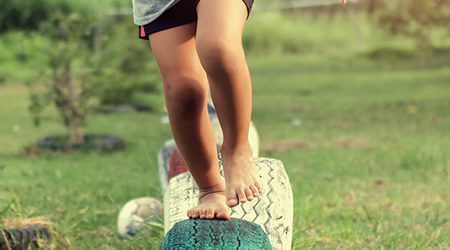Pain in a child’s foot or ankle is never normal. There is no such thing as “growing pains.” Any pain that lasts more than a few days, or that is severe enough to limit the child’s walking, should be evaluated by a foot and ankle surgeon.
Foot problems commonly experienced by children:
- Calcaneal Apophysitis (Sever’s Disease): Calcaneal apophysitis is a painful inflammation of the heel’s growth plate. It typically affects children between the ages of eight and 14 years old because the heel bone (calcaneus) is not fully developed until at least age 14. Until then, new bone is forming at the growth plate (physis), a weak area located at the back of the heel. When there is too much repetitive stress on the growth plate, inflammation can develop.
- Ingrown Toenails: Tight shoes or socks or incorrect nail trimming are the most common cause of ingrown toenails in children, although sometimes the tendency for nails to curve inward is inherited. When the nail breaks the skin, serious infections can result. Parents should never try to dig the nail out at home; treatment by a doctor is advised.
- Plantar Wart (Verruca Plantaris): Warts can develop anywhere on the foot, but they typically appear on the bottom (plantar side) of the foot. Plantar warts, which are caused by the human papilloma virus, the same virus that causes warts on other parts of the body, commonly occur in children and adolescents. These warts grow deep into the skin and can make walking or standing painful.
- Sports Injuries and Sprains: Children begin sports at a younger age than ever, and occasionally, a sprain comes along with the territory. Improper care and physical therapy after a sprain can lead to long-term complications, so come see us today for the care and attention your child’s injury deserves.
- Fractures and Repetitive Stress Injuries: Also common in young athletes are fractures and overuse injuries. For children involved in high-impact sports, or those who just enjoy the riskier activities in life, fractures of the foot, toes, and heel can put a serious damper on their fun. Young bones need proper care to heal correctly, and our pediatric foot care professionals can help.
- Sever’s Disease and Heel Pain: Has your child complained about heel pain? This could be a sign of Sever’s disease, a true “growing pain” of sorts caused by your child’s heel growth plate growing faster than the Achilles tendon. This can cause pain as the tendon and leg muscles strain to accommodate quickly growing bones; simple orthotic inserts and stretching therapy can greatly reduce tightness and pain.
- Flat Feet: Most babies and young children have very flat feet, but after the age of seven, the structure of the foot will likely remain the same. Flat feet in children are usually due to the hereditary shape of the foot rather than an injury, but left untreated, may cause lifelong knee, hip, and back problems.
- Pediatric Bunions: Kids can get bunions too, and in fact, it’s important to treat them as soon as possible to slow progression. Stretches, orthotics, splints that hold the toe in proper position, and shoes that fit properly are all helpful in managing the condition.

